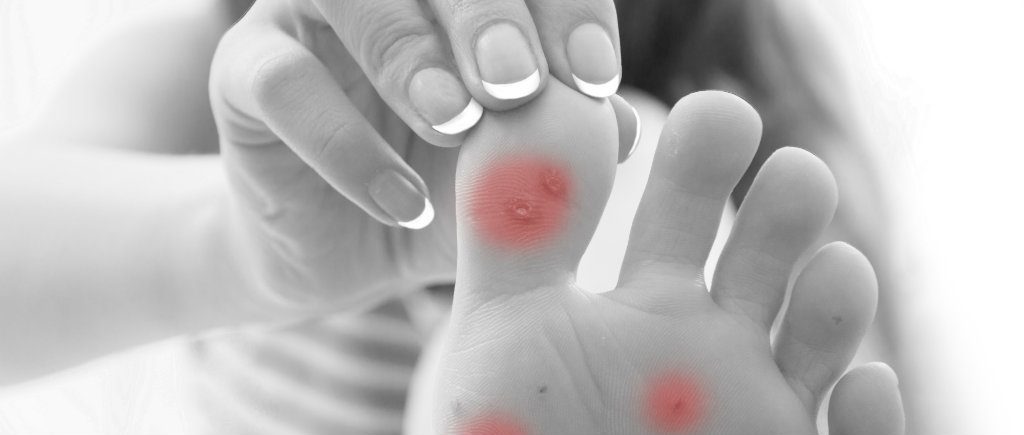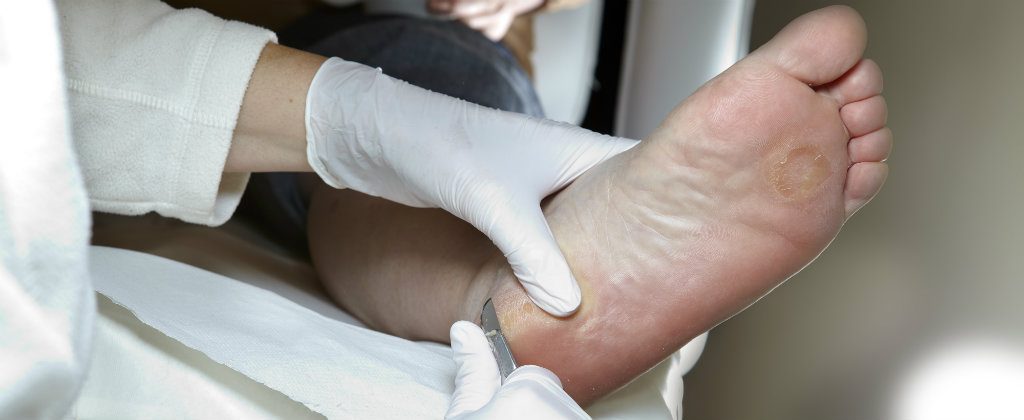Shedding Light on Plantar Wart Myths
Our upcoming Halloween holiday is a time full of myths, stories, and legends—often with a scary or spooky twist. At the end of the day, though, these are pretty much all a matter of fiction.
Fictitious Halloween elements add to the fun and excitement of the holiday, but myths in real-life can be problematic. Why is that? Put simply, because people need to know the actual reasons for problems if they want to resolve them.
One foot problem in particular has a variety of myths around it that keep people from getting the help they need. That foot problem is plantar warts.
As with various elements of Halloween, the mere thought of having a wart can be enough to make most peoples’ skin crawl. With that being the case, they will seek out treatment options or use preventive measures—and these might not work if they’ve heard these common wart myths.
If you’re seeking advice on how to prevent or treat a plantar wart, you really need to separate the fact from the fiction.
Breaking Common Wart Myths
In spite of their commonality—most people will grow at least one wart at some point during their lives—warts tend to be rather misunderstood. Not helping are myths like the following:
- Warts come from frogs. Let’s take those amphibians right off the hook – you will not contract a wart from touching a frog with your bare hands. The bumpy growths actually come from the human papillomavirus (HPV), not toads or frogs. As you look to avoid growing a wart, this is simply not a concern (even if people think it is).
- Warts have seeds or roots. This particular myth stems from the fact that you can often see black dots through the translucent growth. Those aren’t seeds or roots, however. What you are observing are simply the ends of tiny blood vessels that have grown in that direction. (HPV is actually microscopic and cannot be seen by the human eye.)
- Warts are not contagious. In fact, warts are contagious and can be spread from person to person through direct contact. All it takes is a small cut or abrasion and the virus can enter the skin and cause a viral growth.
- It is impossible to reduce the risk of warts. This is simply not true. Whereas prevention methods do not completely eliminate the risk, you can reduce the odds by boosting your immune system and not making direct contact with someone else’s wart.
- Over-the-counter wart removal kits are safe and effective. With most store-bought kits, there is either too much salicylic acid (the most common active ingredient used to “burn” off warts) or too little. Excessive acid can damage healthy tissue around the wart; whereas insufficient acid won’t appropriately eliminate the problem wart.
- Warts are harmful/harmless. Either way, this myth isn’t particularly true. Sure, warts are benign (noncancerous), but they can cause pain and discomfort – and especially plantar warts that grow on the bottoms of feet. Furthermore, warts actually can lead to major problems if diabetes is also in the picture.
Now that those myths have been cleared up, let’s take a closer look at this problem.
Viral Infections: The Root Cause of Plantar Warts
As we noted, the human papillomavirus (HPV) is the virus responsible for plantar warts. HPV has over 100 different strains and the majority of them do not actually lead to warts on your feet. Even when the outer layer of your skin is infected by one that does, you may or may not end up with a wart.
Basically, everyone’s immune system reacts differently to HPV, so one person will develop plantar warts from exposure to a particular strain, whereas the next person might not—even if both people are related!
The transmission of the responsible virus does not have to be direct for an individual to be infected. For this reason, a common path to infection comes from walking barefoot in an environment where HPV thrives. That said, another means of transmission is coming into contact with a wart. This can happen when you touch a wart and then a different part of your body or when a parent is attending to a child’s plantar wart.
Plantar Warts Are Generally Harmless, But…
Whereas a plantar wart is typically a benign (harmless) growth, it can lead to pain when you walk or stand. If the pain or discomfort is substantial, it may cause you to alter your gait, and such changes can potentially lead to joint or muscle issues (because you’re likely placing extra pressure on areas not accustomed to handling the force loads).
If you have diabetes, you should already be using a daily foot check as part of your diabetic foot care plan. When inspecting your feet, take note of the development of any warts and schedule an appointment with our office when you find one. You do not want to risk this leading to a serious medical complication.
Know Your Wart Treatment Options
If you want to “wait out” a plantar wart, you can certainly do so. These growths usually go away on their own, without any treatment. The catch, though, is that this can take up to a couple of years. There are a variety of reasons for wanting to remove them—they are causing pain, you have diabetes, warts make you self-conscious, etc.—and, fortunately, we can help.
Now, you may be tempted to try home remedies—retail stores and nationwide pharmacies often have over-the-counter kits for sale—but these only work about half of the time (if even that often) and provide the risk of damaging healthy skin around the wart.
It is especially important not to try wart removal on your own if you are diabetic!
We cannot emphasize this enough: do not attempt to remove a wart with “bathroom surgery.” Doing so puts you at unnecessary risk for infection and injury. Your best course of action is to simply let Dr. Spencer handle the problem for you.
Our office will work with you to ensure that your plantar warts are effectively and safely removed. Treatment options that we offer include topical or oral treatments, cryotherapy (freezing), acid treatments, or surgery to remove the wart.
Tips for Preventing Plantar Warts
As we’ve noted, HPV thrives, and is often transmitted, in environments that are damp and warm. For this reason, a major plantar wart prevention tip is to protect your feet in areas like gym locker rooms, showering areas, and indoor pool decks. We certainly encourage you to go to health clubs, pools, and gyms to get exercise, but make sure you wear sandals or shower shoes when changing or walking around. This helps you avoid contact with the virus.
Another way the virus can be contracted is by making contact with someone else’s wart. In the event you accidentally touch one or are attending to an afflicted child, make sure you wash your hands or whatever area was exposed as soon as possible.
In addition to skin-to-skin contact, the HPV can be passed along by items. This means you shouldn’t share someone else’s socks, shoes, towels, razors, or other such items if you want to reduce your risk of growing a plantar wart.
Whereas there is a certain risk factor for picking up the virus in a public place, the odds are even greater if a family member has a wart. In order to prevent the viral growths from spreading within your family, here are some additional preventative measures you can take:
- Keep the wart dry. Moisture allows the virus to thrive and spread more easily.
- Wash your hands after exposure. Use an antibacterial soap and warm water to wash away any viral contamination.
- Cover the wart with a bandage. This can help prevent the common temptation to pick at the wart, which can lead to the HPV spreading.
- Have your wart removed. Warts will actually disappear in time, but this can take as long as a couple of years. Instead of waiting, simply schedule an appointment with our office and we can remove the plantar wart for you!
Professional Plantar Wart Removal
If a plantar wart is causing you pain and discomfort, or you would rather not wait a couple of years for it to go away, contact Southern California Foot & Ankle Specialists. Dr. Spencer will be happy to take care of the problem for you. Contact our Ladera Ranch, CA office by calling (949) 364-9255 (WALK) or using our online form to request an appointment today.


